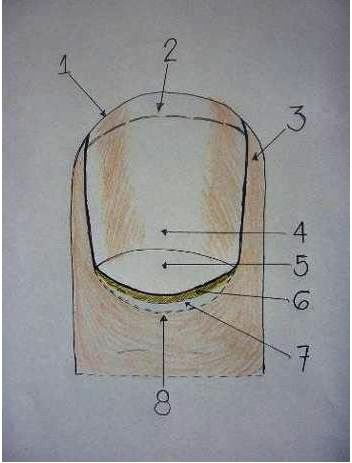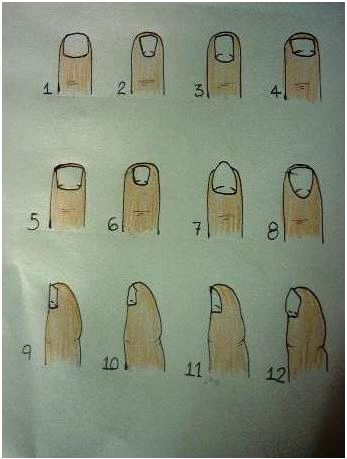Basic characteristics of nails
Structure and parts.
To begin, it is very important to know the structure of a nail an the parts that compose it. This will help us identify the parts we will work on and the way to treat them without a problem.
The nail is a membrane with the shape and texture of a plate, which has 3 layers of keratin (a protein with spiral structure). It is located at the face of the last phalanx, both on our hands as well as our feet.
In regards to the 3 layers it possesses, the first layer is the one which is exposed. It is called keratin. The second layer is called mid keratin and the third layer is called sensitive keratin. The three layers are very delicate; they can be scratched or separated due to an excessive use of scissors or nail clippers.
It is important to point out that any treatment we apply always affects the 3 layers we mentioned previously since these layers, besides being bonded by fat and humidity, possess pores which enable the absorption of products.
The next step is to know the most important parts that compose or surround the nail. The following image will help you learn them easily:

1. Border
2. Distal edge of nail
3. Nail groove
4. Nail plate
5. Lunula
6. Cuticle
7. Eponychium
8. Proximal nail fold
Knowing these parts is very important to perform a manicure and to understand other aspects related to the treatment of nails; for example, their growth.
Our nail grows parting from the Eponychium. According to several studies, it grows an approximate of 0,1mm daily during adulthood. This indicates that the recovery of a full nail takes from 5 to 6 months. On the other hand, the lunula (sometimes known only an 'lune' or 'moon') works as an age indicator: during childhood, it is quite faint; during adulthood, it is quite marked; in the elderly, it is usually flat or dull.
A healthy nail
One of the most important aspects we need to take into consideration at the moment of performing a manicure session is the state of the nail: if its healthy or not.
It is vital for us to recognize a healthy nail. This will let us know if the session is to be done in a regular manner or not.
Manicure sessions on sick nails have another meaning besides aesthetics; they function as a treatment parallel to another treatment prescribed by a doctor.
A healthy nail presents the following characteristics:
- Its colour must be a blend of white and pink and translucent.
- Its appearance should denote porosity.
- Its exterior texture must be firm and flexible.
- Its internal texture must be watery.
Nail shapes
It is also important for us to know the shape of nails. Of course, nails can vary in every person, but we can generally mention that there are 12 shapes. We can see the 12 general shapes in the following image:

(1) large
(2) small
(3) thin
(4) wide
(5) squared
(6) small squared
(7) almond shaped
(8) hazelnut shaped
(9) slightly convex
(10) convex
(11) concave
(12) curved
Learning to identify the type of nail we will treat is essential for us to be able to treat or trim correctly.
Here, we will show you how to polish or trim depending on the type of nail. Those nails with the shapes 1, 2, 3 and 4 must never be sanded/polished or trimmed until we reach the skin. Besides, it is necessary to let the edges grow to achieve an oval shape. Those nails with the shapes 5, 6, 7 and 8 must be sanded/polished or trimmed following the angle they present (generally, an oval shape). Those nails with the shapes 9, 10, 11 and 12 must be sanded/polished or trimmed trying to leave a few millimetres from the edge of the skin, following a perpendicular line to the finger.
As we mentioned previously, these forms needn't to be exact. The idea is for you to compare the nail you are going to treat with the models we have presented to you. You need to assess which one is the best match.
Perfect! Now, you know the basic notions of nail characteristics. We can proceed to the Next Lesson. On lesson 3, we will show you the materials you need to perform a manicure session correctly.

